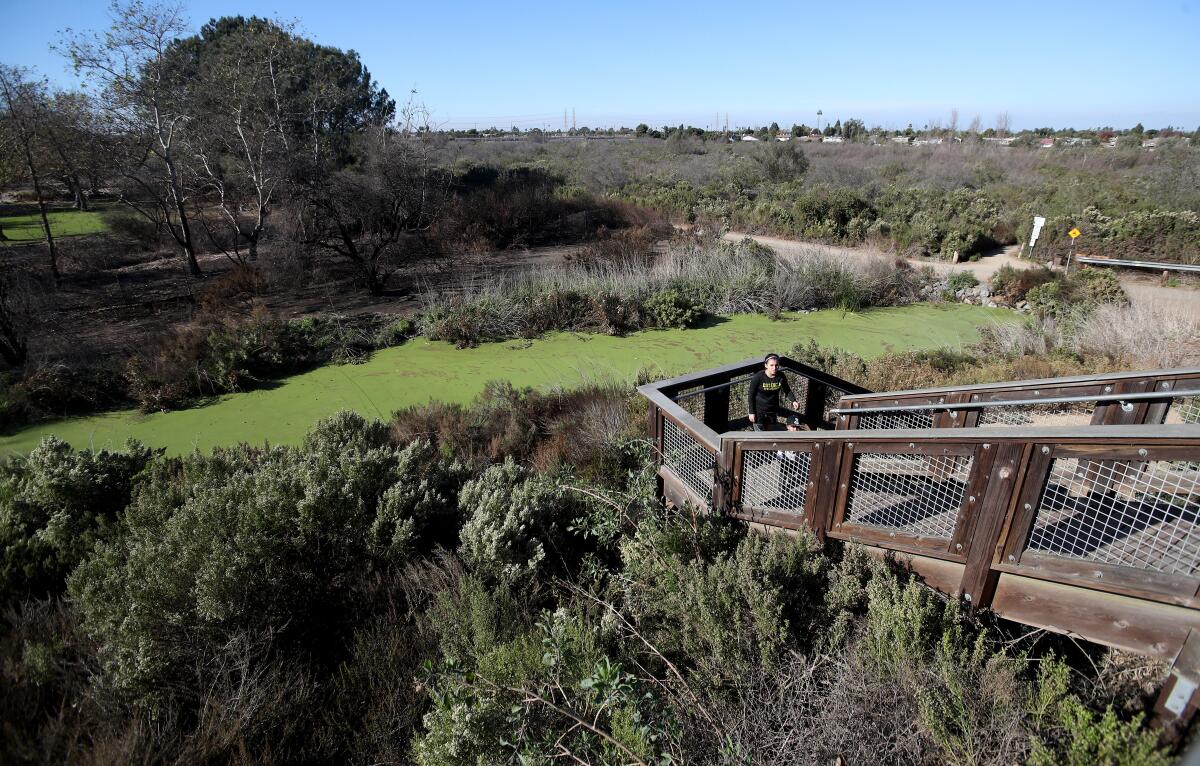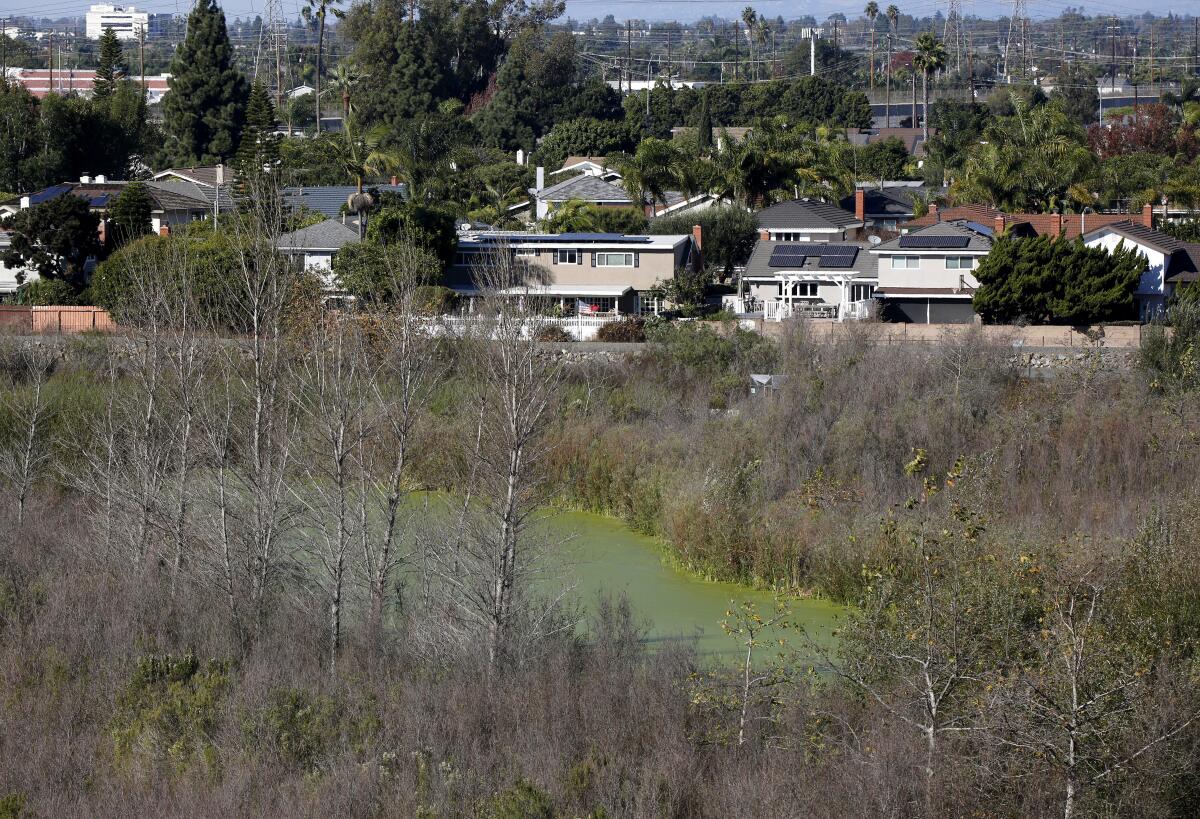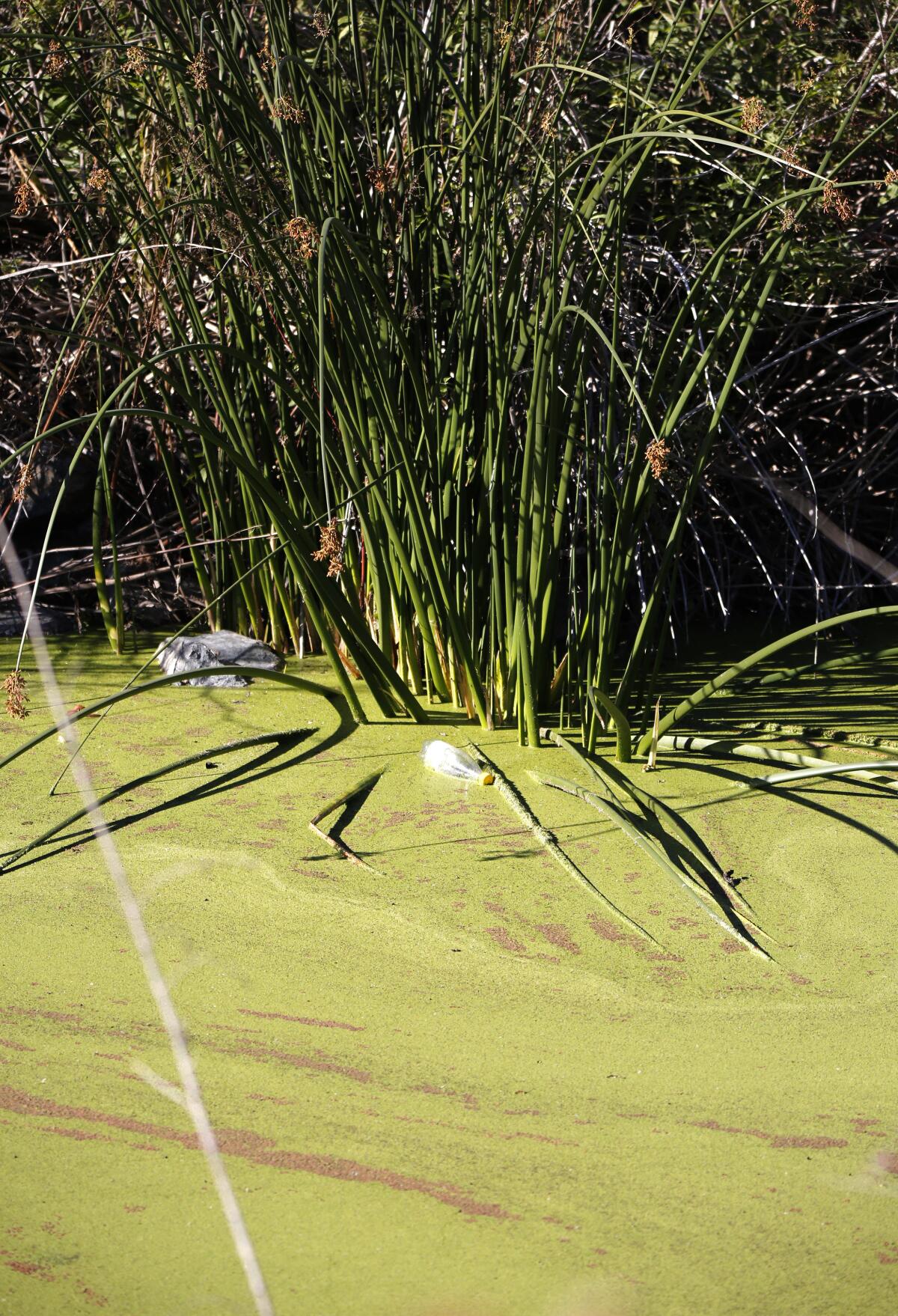Costa Mesa’s Fairview Park Wetlands, once seen as a boon, is bogged down by deficiencies

- Share via
When Costa Mesa opened a 37-acre wetland complex at Fairview Park in 2013, the project was celebrated as an environmental accomplishment. City officials at the time described it as a “perfect marriage” of engineering and ecology.
Its 23 acres of riparian habitat would provide refuge to species threatened or endangered by years of Orange County development, and a recirculating pond system would draw urban runoff from nearby Greenville Banning Channel and suffuse flows throughout a web of interconnected streambeds.
Residents could recreate on trails that would provide vistas of rock-lined streams, overflown by red-tailed hawks and Northern harriers, while mosquitofish would keep pesky insect populations at a tolerable level.
But seven years into the project — and just one year before Costa Mesa is to negotiate a final conservation agreement with the U.S. Army Corps of Engineers and Orange County’s Flood Control District and Transportation Authority — the project has become mired in problems.
Reported deficiencies in the design and construction of the water delivery system have resulted in poor water circulation that has caused algae to overbloom, while cattails and duckweed are growing like wildfire along pond shores, creating conditions ripe for mosquitoes.

Costa Mesa City Council members convened in a study session Tuesday to address the issue of mosquito abatement at Fairview Park, where at least one insect sample tested positive for West Nile virus in August. During the discussion, many issues with the area rose to the surface.
Fairview Park administrator Cynthia D’Agosta said maintenance costs have ballooned far beyond the annual $40,000 anticipated at the outset of the work.
“The [conservation] agreements stated initially that the maintenance and management would require little to no investment from the city, but shortly into the development of the project the system became more costly and challenging,” she told the council Tuesday.
D’Agosta said the city spends some $350,000 annually on clearing overabundant cattails and performing other necessary maintenance. In 2018, the city removed 16 tons of cattails over eight weeks in summer and had to return in winter with mowing equipment.

Meanwhile, data provided by the Orange County Mosquito and Vector Control District show mosquito counts are on the rise. In 2015, when the wetland area was still new, the district counted fewer than 200 insects in Fairview Park traps. By the following year, the count rose to 1,684.
Although only 262 mosquitoes were counted last year, in 2020 more than 800 insects have so far been reported in traps. Higher populations could pose a health risk to residents as Orange County West Nile cases also rise.
As of Monday, 329 mosquito samples countywide had tested positive for West Nile virus — a 37% increase over 2019 totals and 68% above figures calculated in 2018. Some 17 human cases of the virus have been reported so far this year, compared with seven last year and 11 the prior year.
In Costa Mesa this year, three mosquito samples and three dead birds have tested positive for West Nile, and one nonlethal human case has been recorded. No insects or birds were found with the virus inside city limits in 2018 and 2019.
Costa Mesa resident Bill Turpit has been following the wetlands project since plans started coming to fruition in 2007. On Tuesday, he blamed faulty design and construction for “fundamental deficiencies” in the wetland system that have contributed to the mosquito problem.
City staff estimated Thursday that Costa Mesa spent about $4.7 million to build the wetland area. The ponds and water delivery systems were completed by Orange County contractor Land Forms Landscape Construction, which has since closed operations.
Turpit said improper soil elevation on the site prohibits gravitational flow, and plant overgrowth leaches from the water vital oxygen mosquitofish need to survive.
A float valve and pump intended to recirculate water from one end of the system to the other were never installed, he continued, causing excess flows to spill out onto a western portion of the property near adjacent Talbert Park that residents call “The Swamp.”
“It’s kind of like building a highway but forgetting to build the bridges,” he said. “It appears that the city accepted the wetland system without it being constructed according to plan.”
Mayor Pro Tem John Stephens said several neighbors have told him they cannot go outside their homes without being swarmed by mosquitoes. The situation is not only creating a health issue but draining city finances.
“I think this could be one of those situations where if we don’t make a capital investment, we’ll continue to suffer a year-over-year operating loss,” he said. “The time is now to be aggressive about it.”
City officials agreed to form a working group with neighbors and experts who could determine the most economic and effective way to immediately address the problems.
Mayor Katrina Foley asked to convene a closed session later this month to discuss possible legal remedies, and said she favored taking decisive action.
“I actually was on the council in 2007 when they made those promises to us,” Foley said. “We need to have an action plan … so that the council knows sooner rather than later what we need to do to move forward to fix the problem.”
Cardine writes for Times Community News.
More to Read
Sign up for Essential California
The most important California stories and recommendations in your inbox every morning.
You may occasionally receive promotional content from the Los Angeles Times.











